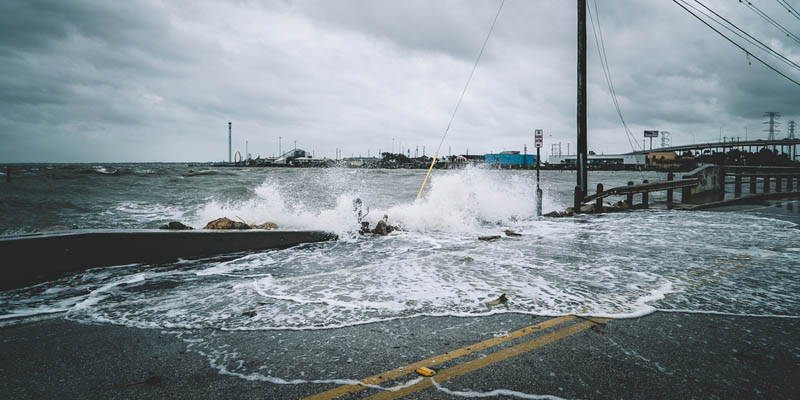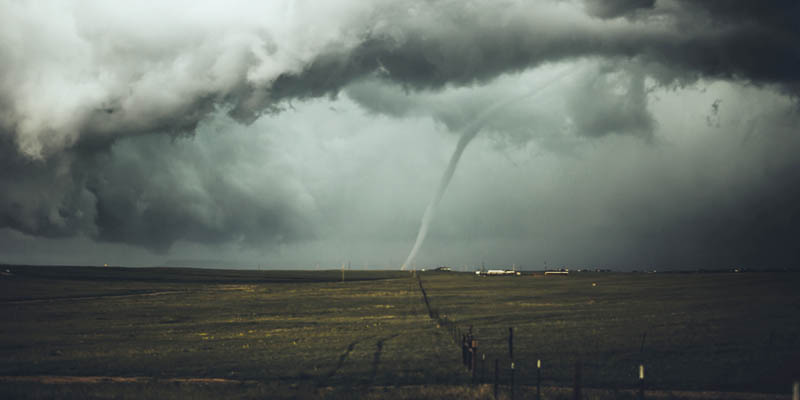Table of Contents
We explore tornadoes, and explain how they are formed. In addition, we discuss their characteristics, classification, and effects.

What is a tornado?
A tornado is a meteorological phenomenon of short duration and extent in which a whirlwind rotates at high speed. It is one of the deadliest and most destructive weather events.
While tornadoes may vary in shape and size, they typically appear as a rotating tube-shaped series of clouds forming a funnel from the sky to the ground, with a cloud of debris and dust usually revolving around it. Their winds are so intense that they pick up and take everything in their path.
Tornadoes are unpredictable, which makes them extremely dangerous. They often form in an instant, move rapidly, and can change direction in a matter of seconds, making them even more difficult to predict.
They are short-lived phenomena, usually lasting from a few seconds to an hour. The average duration of a tornado is about 10 minutes.
- See also: Thunderstorm
How do tornadoes form?
A tornado forms when a warm, moist air mass meets a cold, dry air mass. The collision of air masses of different temperatures and humidity can produce thunderstorms and strong currents of rising air called updrafts.
When a warm, moist updraft meets cold, dry air in the upper atmosphere, an area of atmospheric instability is created. This instability can cause the column of warm air to form a thunderstorm cloud.
Warm, moist air inside the storm cloud continues to rise, while cool, dry air descends, creating a wind shear in the atmosphere. This wind shear may intensify producing an air vortex that descends from the storm cloud to the surface of the Earth.
As the air vortex descends, its rotational speed can increase, sucking air into the tornado. This can cause the tornado to grow in size and strength, thus increasing the speed of the winds and the amount of damage it may cause.
Types of tornadoes

Depending on their formation, size, duration and intensity, tornadoes can be classified as follows:
- Supercell tornadoes. Formed in heavy thunderstorms, they are violent and destructive tornadoes.
- Non-supercell tornadoes. Formed in smaller thunderstorms, they are usually less powerful than supercell tornadoes.
- Multiple-vortex tornadoes. They consist of two or more air columns rotating around a common axis, which creates several vortices or "tips" of the tornado.
- Satellite tornadoes. They are two tornadoes (a larger and a smaller one) that meet or form very close to each other, the smaller orbiting the larger one and revolving next to it as if it were a satellite (hence its name).
- Wedge tornadoes. Characterized by their wedge or inverted "V" shape, with a wide base and a narrow tip.
- Rope tornadoes. Typically very narrow, they have an extended ropy shape that goes from the surface towards the clouds. They are usually less destructive than typical tornadoes.
- Waterspouts. These tornadoes form over the sea or a large body of water. They may form directly over water or move from land to water.
Effects of tornadoes

The devastation caused by tornadoes may range depending on wind speed and the durations of the tornado. Tornadoes can uproot trees and pick up roofs and smaller objects, which may be carried and tossed at great speed and distance by the power of the tornado winds.
In addition, tornadoes can be highly dangerous for people who are not safely covered in shelters in their wake. They can be swept away by the wind and struck or crushed by flying debris.
The wake of a tornado often results in the disruption of basic services. The blowing down of poles and wires can leave affected areas without electricity, connectivity, and telephone service.
Life cycle of a tornado
The life cycle of a tornado consists of three stages:
- Formation. Tornadoes typically form in a storm system. Warm, moist air rises, while cold, dry air descends. This difference in temperature, atmospheric pressure, and humidity creates an air vortex that begins to swirl starting the formation of the tornado.
- Maturity. Once the tornado is formed, it can reach its maximum size within minutes. This is the most destructive stage, as the tornado attains its maximum rotational speed. It is also when it acquires its typical funnel shape.
- Dissipation. In the final stage of the tornado, the lack of warm, moist air weakens the vortex making it thin like a rope, before the tornado loses its remaining energy and dissipates.
Where do tornadoes form?

Tornadoes have been recorded on every continent except Antarctica, though the majority (about 75%) occur in the United States. 80% of the tornadoes in that country happen in the region known as "Tornado Alley", which covers the states of South Dakota, Nebraska, Kansas, Oklahoma, Iowa, and Texas.
They often form in other regions of the world particularly in southern central Asia, southern Africa, southeastern Australia and New Zealand, and in some parts of South America.
What to do during a tornado
In the event of a tornado, recommendations are as follows:
- In a house, take shelter in the room farthest from windows.
- Outdoors, seek refuge in a nearby building, house, or structure.
- In a vehicle, stop the vehicle and find a safe place to take shelter outside the car.
In all cases, it is important to remain calm, stay informed, not to handle objects or touch wires, and to cover head and body.
How are tornadoes measured?

While most tornadoes have winds with speeds between 40 and 110 miles per hour (65 and 180 km/h), the biggest tornadoes in history have exceeded 250 miles per hour (400 km/h). They can range from a few feet to over 1.25 miles (2 km) in width.
Tornado intensity is measured on the Enhanced Fujita (EF) scale, also known as the Fujita-Pearson Scale. This scale classifies tornadoes according to the damage they cause on a scale from EF0 to EF5, with EF5 representing the most destructive tornadoes and EF0 representing the least destructive.
Worst tornadoes in history
Some of the deadliest tornadoes in history have been:
- The Tri-State tornado in the United States. It occurred on March 18, 1925 and affected the states of Missouri, Illinois, and Indiana. It traveled 202 miles (325 km) in about 3.5 hours at a travel speed of 73 miles per hour (117 km/h). It resulted in 695 deaths and over 2,000 injuries. Although the Fujita scale did not exist at the time, it is believed it would have been rated as F5. It is considered the most devastating tornado in history.
- The Daulatpur-Saturia tornado in Bangladesh. It happened on April 26, 1989, and was the deadliest tornado in history with a death toll of 1,300 people and over 12,000 injured. The tornado was part of a series of thunderstorms that developed in the center of the country. It had an approximate width of 1 mile (1.5 km), moving northward at a speed of 75 miles (120 km) per hour.
Tornadoes in film
Tornadoes are a frightening force of nature that have inspired numerous movies especially in Hollywood, including: Hurricane (1979), Twister (1996), The Perfect Storm (2000), The Day After Tomorrow (2004), The Hurricane Heist (2012), and Into the Storm (2014).
In comedy, Sharknado (2013) and its sequels feature a tornado tossing sharks into Los Angeles.
Explore next:
Was this information useful to you?
Yes NoThank you for visiting us :)